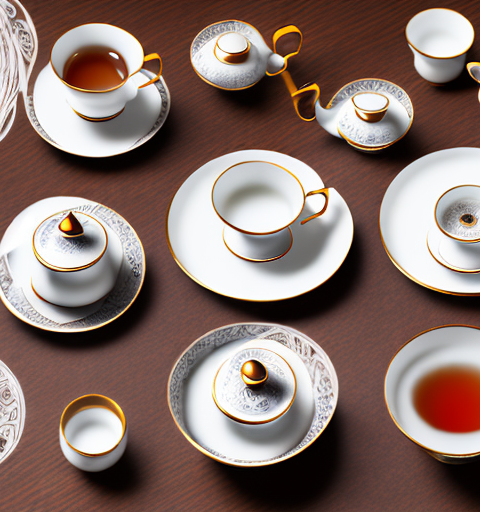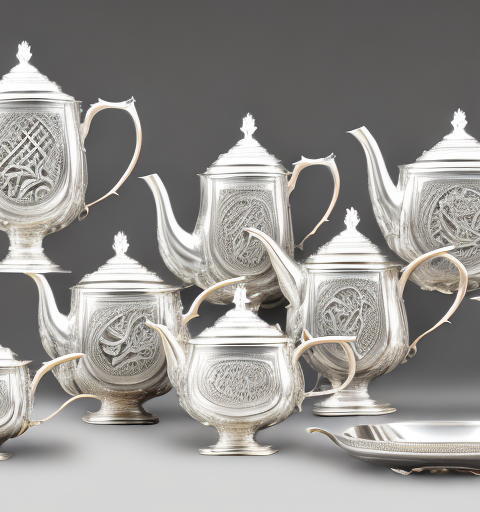The handle of a ceramic teapot can often become extremely hot when boiling water is poured into it. This can be a major inconvenience, as it can make it difficult to safely handle the teapot when preparing or serving tea. In this article, we will explore the reasons why the handle of a ceramic teapot gets hot and discuss various methods to prevent this issue.
Understanding the problem: Why does the handle of a ceramic teapot get hot?
The heat transfer in a ceramic teapot occurs due to the excellent thermal conductivity of ceramics. When hot water is poured into the teapot, the heat quickly travels through the walls and into the handle. Since ceramic material does not provide much insulation, the handle becomes hot to the touch, making it uncomfortable and potentially dangerous to handle.
One way to mitigate the issue of a hot handle on a ceramic teapot is to use a handle cover or a tea cozy. These accessories provide an extra layer of insulation, reducing the amount of heat that reaches the handle and making it safer to handle the teapot.
Another factor that can contribute to the handle of a ceramic teapot getting hot is the design of the teapot itself. Teapots with a larger surface area exposed to the hot water, such as those with a wider opening or a shorter spout, may transfer more heat to the handle compared to teapots with a more compact design. Therefore, choosing a teapot with a design that minimizes heat transfer to the handle can help prevent the handle from getting too hot.
The dangers of a hot teapot handle: Why it’s important to take preventative measures.
A hot teapot handle can pose several risks. Firstly, it can cause burns or scalds to the hands of the person handling the teapot. This is especially dangerous when dealing with boiling water, as severe burns can occur. Secondly, the discomfort caused by a hot handle can make it difficult to pour tea properly, leading to spills and accidents. Lastly, if children or pets are around, a hot teapot handle can pose a significant hazard to their safety.
It is important to take preventative measures to avoid the dangers of a hot teapot handle. One effective measure is to use a tea cozy or a handle cover to insulate the handle and protect your hands from burns. Additionally, always use oven mitts or pot holders when handling a hot teapot to further minimize the risk of burns. It is also advisable to keep the teapot out of reach of children and pets to prevent any accidents or injuries. By taking these preventative measures, you can enjoy your tea without worrying about the hazards of a hot teapot handle.
Choosing the right material for your teapot handle: What materials are best for heat resistance?
When selecting a teapot, it’s important to consider the material used for the handle. Some materials are better at resisting heat transfer than others. One popular choice is silicone, which is known for its excellent heat resistance. Silicone handles stay cool to the touch even when the rest of the teapot is hot. Another option is wood, which is a natural insulator. Wood handles can provide a comfortable grip and remain relatively cool. However, it’s important to ensure that the wood handle has been properly treated and sealed to prevent any moisture absorption or damage. Other materials such as heat-resistant plastic or metal coated with heat-resistant material can also be suitable choices.
Another material that is commonly used for teapot handles is stainless steel. Stainless steel handles are durable and have good heat resistance. They can withstand high temperatures without becoming too hot to handle. Additionally, stainless steel handles are easy to clean and maintain.
For those looking for a more traditional option, ceramic handles can also be a good choice. Ceramic handles have good heat resistance and can add a touch of elegance to your teapot. However, it’s important to handle ceramic handles with care as they can be more fragile compared to other materials.
Insulating your teapot handle: Tips and tricks to keep it cool to the touch.
There are several methods to insulate a teapot handle and prevent it from getting hot. One approach is to use a handle cover or sleeve made from a heat-resistant material such as silicone or neoprene. These covers slip over the handle, creating a barrier between your hand and the hot surface. Another option is to wrap the handle with a heat-resistant tape, which acts as insulation. This method provides an extra layer of protection and can be easily removed if necessary. Additionally, you can consider using a teapot cozy, which is a specially designed cloth cover that wraps around the teapot, including the handle, providing insulation and keeping the teapot hotter for longer.
Furthermore, another effective method to insulate your teapot handle is by using a heat-resistant grip. These grips are typically made of silicone or rubber and are designed to fit snugly around the handle, providing a comfortable and heat-resistant surface to hold onto. They are easy to install and remove, making them a convenient option for those who frequently use their teapot. Additionally, some teapots come with built-in insulated handles, which eliminate the need for additional insulation methods. These handles are designed to stay cool to the touch, ensuring a safe and enjoyable tea-drinking experience.
DIY solutions for a hot teapot handle: Creative ways to protect your hands from burns.
If you prefer a more hands-on approach, there are several DIY solutions you can explore to protect your hands from a hot teapot handle. One option is to create a handle cover using a thick, heat-resistant fabric such as quilted material or oven mitts. By sewing or fastening the fabric around the handle, you can effectively insulate it. Another idea is to repurpose items like foam sleeves typically used for water bottles or even cut pieces of pipe insulation to fit around the handle. These materials provide good insulation and are readily available.
Additionally, you can also consider using heat-resistant silicone grips or sleeves specifically designed for teapot handles. These grips are often made with non-slip material, providing a secure and comfortable grip while protecting your hands from heat. They are easy to slip on and off, making them convenient for use with different teapots. Some silicone grips even come in fun and colorful designs, adding a touch of style to your teapot.
The importance of proper teapot usage: How your pouring technique can affect handle temperature.
While insulation methods can help, it’s also important to consider your pouring technique when trying to prevent the handle of a ceramic teapot from getting hot. When pouring, tilt the teapot at an angle that minimizes the exposure of the handle to the steam or hot water. By pouring slowly and keeping the handle away from the direct line of steam, you can further reduce the heat transferred to the handle. Additionally, using a teapot with a well-designed spout that minimizes drips and spills can also aid in maintaining a cooler handle temperature.
Another factor to consider when trying to maintain a cooler handle temperature is the material of the teapot itself. Ceramic teapots tend to retain heat more than other materials such as glass or stainless steel. Therefore, opting for a teapot made from a different material may help in preventing the handle from getting too hot.
Furthermore, it is important to note that the size and shape of the teapot can also impact handle temperature. A teapot with a larger surface area exposed to the hot liquid may result in a hotter handle. Choosing a teapot with a smaller surface area or a narrower shape can help minimize heat transfer to the handle.
Investing in a heat-resistant teapot: Is it worth the cost?
If you frequently encounter the issue of a hot teapot handle and are willing to invest in a long-term solution, purchasing a teapot specifically designed to be heat-resistant may be a worthwhile investment. Heat-resistant teapots are often made from materials such as borosilicate glass or certain types of ceramic that resist heat transfer. These teapots are designed to stay cooler to the touch, including the handle, even when boiling water is poured into them. While these teapots may be more expensive than traditional ceramic teapots, they offer the convenience of a consistently cool handle, making your teatime experience safer and more enjoyable.
One of the key benefits of investing in a heat-resistant teapot is its durability. Heat-resistant materials, such as borosilicate glass, are known for their strength and resistance to thermal shock. This means that the teapot is less likely to crack or shatter when exposed to sudden temperature changes, ensuring that it will last for a long time with proper care.
In addition to their heat-resistant properties, some heat-resistant teapots also come with built-in infusers. These infusers allow you to brew loose-leaf tea directly in the teapot, eliminating the need for a separate tea strainer or infuser. This added convenience makes the teapot a versatile tool for tea enthusiasts who enjoy experimenting with different types of loose-leaf teas.
Maintaining your teapot handle’s heat resistance: Cleaning and care tips.
To ensure that your teapot handle continues to resist heat effectively, it’s important to maintain proper care and cleanliness. Regularly clean the handle using a mild dish soap and a soft cloth or sponge. Avoid using abrasive materials or harsh chemicals that could damage the handle’s surface or reduce its thermal insulation properties. Additionally, check the handle regularly for any signs of wear or damage. If you notice any cracks, chips, or deterioration, it’s best to either repair or replace the handle to ensure continued heat resistance.
Another important tip for maintaining your teapot handle’s heat resistance is to avoid exposing it to extreme temperature changes. Rapid changes in temperature can cause the handle to expand or contract, potentially leading to cracks or other damage. When using your teapot, try to avoid placing it directly on a hot stove or in a cold refrigerator. Instead, allow the teapot to cool down or warm up gradually before exposing it to different temperature environments. By taking these precautions, you can help prolong the lifespan of your teapot handle and ensure its continued heat resistance.
Alternatives to traditional teapots: Exploring modern designs with cool-touch handles.
If you’re seeking alternative options to traditional ceramic teapots, there are modern designs available that prioritize heat insulation. Some teapots feature double-walled construction, where an inner layer of heat-resistant material is surrounded by an outer layer that remains cool to the touch. These double-walled teapots effectively prevent heat transfer to the handle. Alternatively, you can explore teapots made from other materials with excellent thermal insulation properties, such as stainless steel or vacuum-insulated models. These teapots offer superior heat resistance and can keep your tea hot for longer periods without heating up the handle.
Another option to consider is teapots with ergonomic designs that prioritize comfort and ease of use. These teapots often feature handles that are specifically designed to fit comfortably in your hand, reducing strain and providing a secure grip. Some designs even incorporate non-slip materials or textures on the handle to further enhance grip and prevent accidents.
In addition to heat insulation and ergonomic designs, modern teapots also offer a range of innovative features. For example, some teapots come with built-in infusers or strainers, allowing you to brew loose-leaf tea directly in the pot without the need for additional accessories. Others may have integrated temperature control settings, allowing you to adjust the water temperature to suit different types of tea. These features not only enhance convenience but also provide a more customizable tea brewing experience.
Expert advice on preventing a hot teapot handle: Insights from tea enthusiasts and professionals.
To gain further insights into preventing a hot teapot handle, it’s valuable to seek advice from tea enthusiasts and professionals. Tea forums and online communities often provide a platform to discuss different teapot models and share personal experiences. Tea experts and professionals can offer valuable advice on selecting teapots with cool-touch handles or provide suggestions on effective insulation methods based on their expertise. Engaging in these conversations can not only enhance your teapot knowledge but also provide practical tips for a more enjoyable teatime experience.
Frequently asked questions about ceramic teapot handles and heat prevention.
1. Can I directly use oven mitts or pot holders to handle a hot teapot?
Oven mitts or pot holders designed for handling kitchenware are not recommended for directly handling a hot teapot. These items are typically bulkier and less precise than handle covers or sleeves specifically designed for teapots. They may compromise your grip or dexterity, making it more difficult to pour tea safely.
2. Is attaching a cloth or towel around a teapot handle a safe heat prevention method?
While wrapping a cloth or towel around a teapot handle may provide some level of insulation, it is not the most effective or safest method. The fabric may absorb liquid, become hot, or even catch fire if it is too close to the teapot’s spout or flame. It is best to use materials specifically designed for heat insulation, such as silicone or neoprene, to ensure optimal safety and functionality.
3. Can I use a teapot with a wooden handle on an induction stovetop?
It is essential to check the manufacturer’s instructions regarding the suitability of using a teapot with a wooden handle on an induction stovetop. Some wooden handles are not heat-resistant and may suffer damage or discoloration when exposed to high temperatures. To ensure safety and longevity, choose a teapot with a heat-resistant handle explicitly designed for use on induction stovetops.
Teapot accessories that can help cool down the handle: A roundup of useful products on the market.
Several teapot accessories are specifically designed to cool down the handle and enhance your teatime experience. These include silicone handle covers, neoprene handle sleeves, heat-resistant tape, teapot cozies, and quilted handle wraps. These products are readily available online or at specialty tea stores, offering a variety of options to suit your personal preferences and style.
Teatime safety tips for families with children or pets: Avoiding accidents with hot teapots.
When enjoying teatime with children or pets around, it is crucial to prioritize safety to prevent accidents or injuries. Keep the teapot out of reach and on a stable surface to avoid accidental spills or tipping. Opt for teapots with child-safe features such as locking lids or handles that are easy to grip. Additionally, consider using teapot warmers instead of placing the teapot directly on the table, as this reduces the risk of accidental contact with the hot surface.
Comparing different types of teapots for heat insulation: Which style is right for you?
There is a wide range of teapot styles available, each with its unique characteristics and heat insulation abilities. Glass teapots, especially those made from borosilicate glass, offer excellent heat resistance and a visually appealing way to observe the tea brewing process. Stainless steel teapots are known for their durability and superior heat retention. They often feature double-walled construction that keeps the handle cool while keeping the tea hot. Ceramic teapots, although known for their heat transfer, can still be a viable option when combined with proper insulation methods. Ultimately, the choice of teapot style depends on your personal preference, aesthetic taste, and specific requirements.






